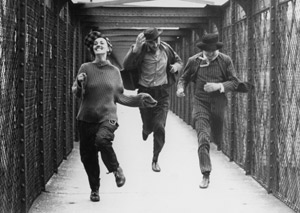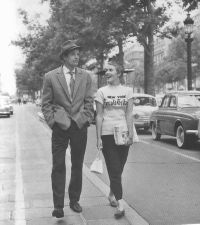 François Truffaut's New Wave film Jules et Jim
François Truffaut's New Wave film Jules et Jim
The New Wave (French: la Nouvelle Vague) was a blanket term coined by critics for a group of French filmmakers of the late 1950s and 1960s, influenced (in part) by Italian Neorealism. Although never a formally organized movement, the New Wave filmmakers were linked by their self-conscious rejection of classical cinematic form and their spirit of youthful iconoclasm. Many also engaged in their work with the social and political upheavals of the era, making their radical experiments with editing, visual style, and narrative part of a general break with the conservative paradigm.
Some of the most prominent pioneers among the group, including François Truffaut, Jean-Luc Godard, Eric Rohmer, Claude Chabrol and Jacques Rivette, began as critics for the famous film magazine Cahiers du cinéma. Co-founder and theorist André Bazin was a prominent source of influence for the movement. By means of criticism and editorialization, they laid the groundwork for a surge of concepts which in later decades of film study (originally in the 1970s) was coined as the auteur theory. It holds that the director is the "author" of his movies, with a personal signature visible from film to film. They praised movies by Jean Renoir and Jean Vigo, and made then-radical cases for the artistic distinction and greatness of Hollywood studio directors such as John Ford, Alfred Hitchcock and Nicholas Ray. The beginning of the New Wave was to some extent an exercise by the Cahiers writers in applying this philosophy to the world by directing movies themselves. Chabrol's Le Beau Serge (1958) is generally credited as the first New Wave feature. Truffaut, with his The 400 Blows (1959) and Godard, with Breathless (1960) had unexpected international successes, both critical and financial, that turned the world's attention to the actitivities of the New Wave and enabled the movement to flourish. Other directors active at the time although not necessarily part of the core Cahiers crew included Louis Malle, Alain Resnais, Agnès Varda, and Jacques Demy.
Contents |
Origins of the Movement
When asked where New Wave began, most will point to a famous film journal named Cahiers du Cinéma. In fact, Chabrol, Eric Rohmer, Jacques Rivette, and others tied closely to the ideas of the movement began as critics for this journal, and used publishing as a lead in to what would soon become a wider attack on the classic ‘literary’ style of French film. French New Wave was “in style” roughly between 1958 and 1964, although popular New Wave work existed as late as 1973. When understanding the basis for New Wave it is vital to recognize the socio-economic forces at play shortly after World War II. A politically and financially drained France tended to fall back to those old traditions which were so popular at the time before war broke out. One such tradition was that of straight narrative cinema, specifically classical French film. The movement has its roots deep in rebellion against this over-reliance on past forms, especially those in which the audience must submit to a dictatorial plot-line derived from old and played-out materials. New Wave critics and directors studied the work of these and other classics. They did not reject them, but rather found a new outlet for the same creative energies. The low-budget approach helped film-makers get at the essential art form and find what, to them, was a much more comfortable and honest form of production. Interestingly, Charlie Chaplin, Alfred Hitchcock, Orson Welles, and many B-film directors were held up in admiration while standard Hollywood films, those bound by traditional narrative flow, were strongly criticized.
Film Techniques
The movies featured hitherto unprecedented methods of expression, such as seven-minute tracking shots (like the famous traffic jam sequence in Godard's Le weekend). Also, these movies featured existential themes, such as the stressing of the individual and the acceptance of the absurdity of human existence.
 Jean-Paul Belmondo and Jean Seberg in Jean-Luc
Godard's Breathless
Jean-Paul Belmondo and Jean Seberg in Jean-Luc
Godard's Breathless
Lightweight cameras, lights and sound equipment allowed the New Wave directors to shoot in the streets, rather than in studios. This fluid camera motion became a trademark of the movement, with shots often following characters down the Paris streets. Many of the French New Wave films were produced on extremely small budgets. Often they were shot in a friends' apartment, and used the director's friends as the cast and crew. Directors were also forced to improvise with equipment (for example, using a shopping cart for tracking shots). The cost of film was also a major concern; thus, efforts to save film turned into stylistic innovations: for example, in Jean-Luc Godard's Breathless (A Bout de Souffle), several scenes feature jump cuts, as they were filmed in one long take: parts that didn't work were simply cut right from the middle of the take, a purposeful stylistic decision.
The cinematic stylings of French New Wave brought a fresh look to cinema with improvised dialogue, rapid changes of scene, and shots that go beyond the common 180º axis. The camera was used not to mesmerize the audience with elaborate narrative and illusory images, but to play with and break past the common expectations of cinema. The techniques used to shock the audience out of submission and awe are in fact so direct and unsubtle that Jean-Luc Godard, one of the most widely known New Wave filmmakers, has historically been accused of having contempt for his audience. His stylistic approach can be seen as a desperate struggle against the mainstream cinema of the time, or a degrading attack on the viewer’s naivete. Either way, the challenging awareness represented by this movement may still be found in cinema today. Effects that now seem either trite or commonplace, such as a character stepping out of her role in order to address the audience directly, were radically innovative at the time. Classic French cinema adhered to the principles of strong narrative, creating what Godard described as an oppressive and deterministic aesthetic of plot. In contrast, New Wave filmmakers made no attempts to suspend the viewer’s disbelief; in fact, they took steps to ensure he/she was constantly reminded that a film is nothing more than a sequence of moving images, no matter how clever the use of light and shadow. The result is a set of oddly disjointed scenes without attempt at unity; or an actor whose character changes from one scene to the next; or sets in which onlookers accidentally make their way onto camera along with extras, who in fact were hired to do just the same. At the heart of New Wave technique is the issue of money and production value. In the context of social and economic troubles of a post-WWII France, filmmakers sought low-budget alternatives to the usual production methods. The jump cut, for example, was often used to make up for the high-cost of film. Half necessity and half vision, New Wave directors used all that they had available to channel their artistic visions directly to the theatre.
Lasting Effects
The style had an impact on American movies as well. After Arthur Penn's Bonnie and Clyde (1967) the New Hollywood directors (e.g. Altman, Coppola, De Palma, Polanski and Scorsese) of the late 1960s/early 1970s made movies inspired by their European (and in particular French) counterparts. The latest American directors who admit a serious influence of the French New Wave are Quentin Tarantino (named his production company A Band Apart after a Godard movie) and Wes Anderson.
Today, one can easily draw ties between New Wave cinema and the avant garde, as well as experimental film, all of which are still present in the culture of cinema. Together they lend an aspect of maturity to the art of film, which in its infancy clung warily to well-structured narrative. Hollywood today is no less bound by the oppressive reliance on necessarily connected sequences and logical story-lines, but a clear divide can be drawn. On one side one has the entertainment which might be gleamed by allowing oneself to fall victim to an entrancing stream of image and sound. This is one allure of cinema, in which the viewer can lose herself in a new world, giving herself to the director and producer’s visions. On the opposite side, there are those films that challenge the audience to think, engage and interact in a way that entertainment simply does not. By challenging the need for strict narrative, these films gain a more direct connection between viewer and director, and often represent a deeper insight regarding the true nature of the medium of film. While it is clear which side the banks and studios are on, the audience has resisted making up its mind. Why have one or the other, one might ask, when in fact cinema can very easily accommodate many different approaches?
Major and Minor Figures
Jean-Luc Godard
François Truffaut
Claude Chabrol
Jacques Rivette
Eric Rohmer
Jean Eustache
See also
External links
Categories: Film theory | Movements in cinema




 216.73.216.81
216.73.216.81 User Stats:
User Stats:
 Today: 0
Today: 0 Yesterday: 0
Yesterday: 0 This Month: 0
This Month: 0 This Year: 0
This Year: 0 Total Users: 117
Total Users: 117 New Members:
New Members:
 216.73.xxx.xx
216.73.xxx.xx
 Server Time:
Server Time: